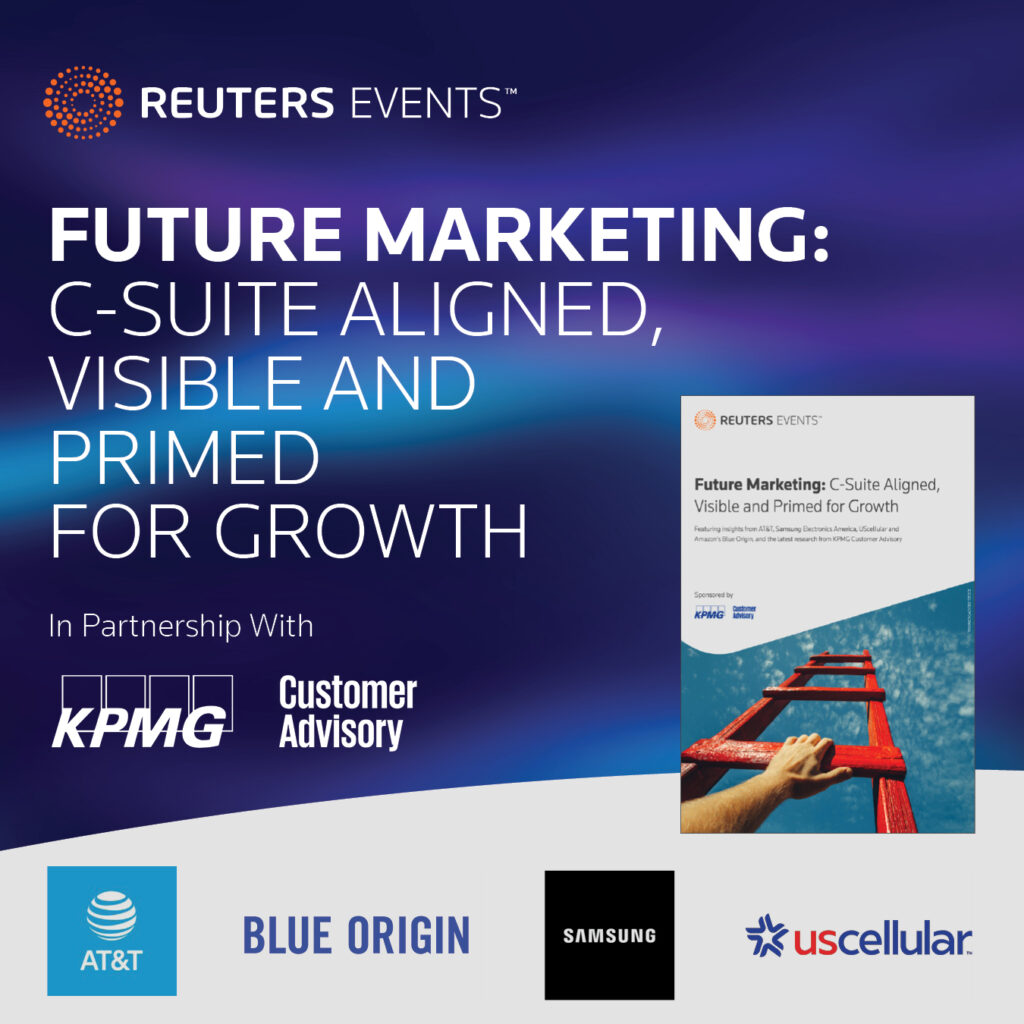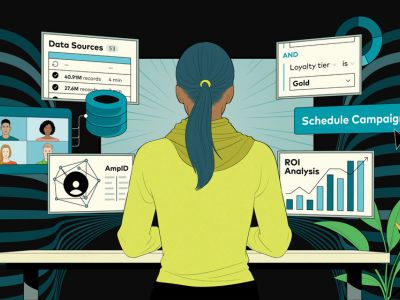Unify your customer data and transform the customer experience: A guide on how to activate personalized insights and engagement
January 8, 2024No matter where a brand is in its marketing journey, now is the time to use learnings from the past decade to improve the customer journey for harmonious, personalized experiences. But since customer data is notoriously fragmented, with online channels failing to connect with offline touchpoints, brands struggle to get a holistic view of individual customers and provide customized, relevant content. And with increasing privacy and security demands, meeting customers’ expectations is more challenging—and more important—than ever.
Adobe believes the future of customer experience management lies in a system of connected applications to power personalized customer experiences. According to a recent Forrester report commissioned by Adobe, Personalization at Scale: Bring Forth the Customer and Business Benefits of Experience Excellence, companies that invest in technology that scales personalization to the entire customer journey overperform in customer acquisition, experience, and lifetime value with a payoff of higher revenue and ROI.
Forrester and Adobe’s Personalization at Scale: Bring Forth the Customer and Business Benefits of Experience Excellence report says, “Companies that invest in technology that scales personalization to the entire customer journey overperform in customer acquisition, experience, and lifetime value with a payoff of higher revenue and ROI.”
Connecting customer data across all touchpoints with personalized insights and engagement empowers brands to redefine what it means to build, grow, and nurture customer relationships. We’re reimagining five timeless use cases to prove how humanizing the customer journey can help you achieve personalization at scale and create inspired customer experiences.
1. Intelligent reengagement.
“Did you forget something?” “You left something behind.” Most consumers today have received the typical abandoned cart follow-up. But these one-size-fits-all messages have a fundamental problem—they account only for the singular abandoned cart event and overlook what happened afterward.
Maybe the customer made a purchase through another channel. Maybe they decided to shop in store. By failing to consider relevant behavioral data across channels, these campaigns lack sufficient information for brands to provide relevant, personalized communications. This lack of real-time data across channels can lead to missed opportunities when the chance of conversion recovery is highest, and it can negatively impact downstream decisioning, budgeting, and optimization.
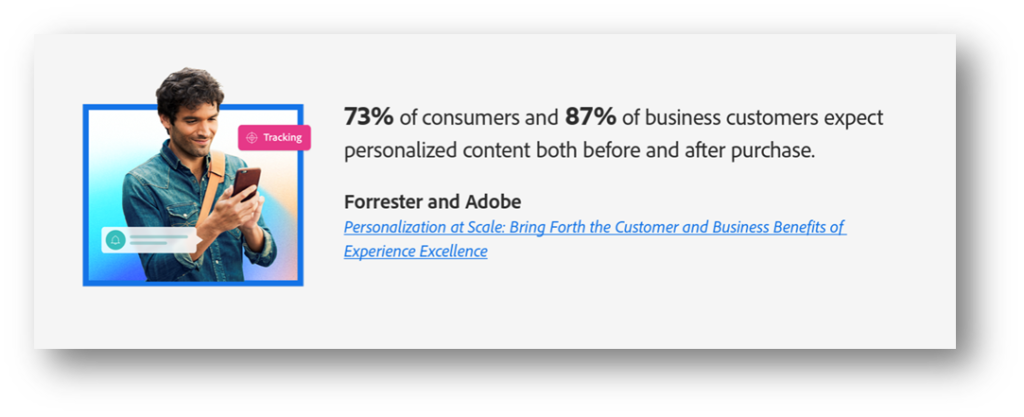
But customers who have previously engaged with your brand present an untapped opportunity. Even though they have abandoned a conversion before completing it, they’ve shown interest and are therefore primed for purchase.
According to the Forrester report, 73% of consumers and 87% of business customers expect personalized content both before and after purchase. By capturing cross-channel behaviors and acting with intelligence and empathy, you can reengage these customers with experiences—not reminders—and create impactful personalization at scale.
Out with the old.
Bombarding all customers with a singular message can be repetitive, irritating, or no longer relevant based on the person’s additional actions. By focusing only on what the person did, instead of who they are, typical abandoned cart campaigns do not support their path to purchase.
Additionally, traditional reengagement campaigns tend to manage customer data in disparate systems, leading to fragmented views, preference and privacy governance risks, and poor customer experiences overall. This results in inconsistent messaging and does not reflect real-time changes in customer behavior and motivation. Latency in suppressing or requalifying a user after an abandoned conversion event can lead to wasted budget and customer annoyance.
In with the new.
Intelligent reengagement, on the other hand, accounts for all customer attributes and behavior, factors in real-time considerations, and it provides instant requalification based on online and offline events. By considering all of a customer’s actions across touchpoints— not just a singular event—brands can create compelling and personalized experiences that engage and inspire.
With intelligent reengagement, you can:
- Identify and analyze abandonment using all relevant behavioral, attribute, and preference data in minutes, not months.
- Design experiences using advanced models such as propensity to reengage, past purchase behavior, and real-time actions.
- Personalize one-to-one reengagement with a canvas that connects multichannel data orchestration, message design, and delivery.
- Deliver abandoned experience messaging at the right time, when it’s most useful in their experience.
- Standardize and sequence all relevant online and offline data into a unified customer view for real-time journey analysis.
2. Customer conversion optimization.
Brands often look at overall conversion rate as a lagging indicator of success and focus on conversion rate optimization to increase the quantity of impressions. But conversion rate is the king of all vanity metrics—it might indicate short-term wins, but by prioritizing quantity over the quality of customer experiences, you risk doing long-term damage to your brand.
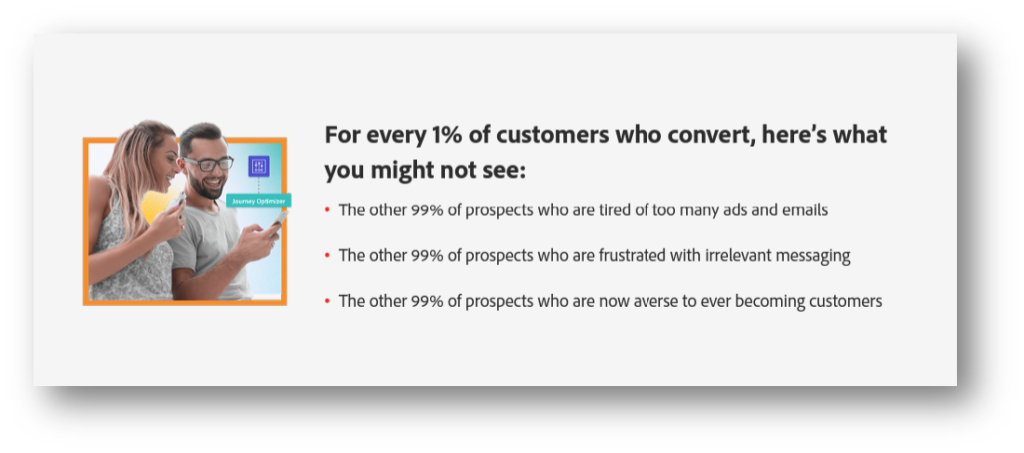
Just one additional ad exposure and avoidance of that same ad decreases the odds of a prospect’s future engagement by 6.7%. Every “irritating” exposure to a consumer causes $0.0015 of economic damage to your business. When generating hundreds of millions of exposures, this can quickly add up to millions of dollars of damage. Customer conversion optimization can change all that.
Out with the old.
Many organizations are continuously challenged with understanding macro-level conversion—such as revenue-generating events—when paired with the contributing factors for any type of conversion event. It can be difficult to micro- and nano-segment customers to launch targeted campaigns for different cohorts to drive registration and conversion. Typical conversion optimization strategies are also confined to digital channels, such as web or mobile, in isolation.
With a lack of knowledge of customer interactions on other touchpoints, brands struggle to plan impactful, multichannel experiences that guide a person from consideration to conversion. As a result, they may continue delivering irrelevant or stale messaging, further risking long-term brand damage.
In with the new.
With customer conversion optimization, brands can turn a prospect currently in the consideration stage into a converted customer. Connected conversion optimization tools analyze each prospect’s experience on a one-to-one basis and improve their unique experience accordingly.
By focusing on each user’s journey and homing in on individual customer success, you can:
- Analyze all the contextual drivers of compelling experiences through both trait and behavioral data to improve conversion events.
- Use advanced segmentation and activation tools for pseudonymous profiles that have not yet registered or converted.
- Scale one-to-one experiences across advertising, social, email, SMS text, and more, using interests and preferred channels to create personalization.
- Use AI modeling to identify indicators and route users down the best path, such as free trials or chat.
Customer conversion optimization is all about balance. Short-term success metrics (like conversion rate) matter, but long-term metrics (like loyalty, lifetime value, brand sentiment, and net promoter score) are what ensure a bright and sustainable future for your brand.
So instead of attempting to generate the same conversion event from broad segments, focus on building one-to-one customer relationships that last, and analyzing the signals and patterns of success. Your conversion rates will naturally improve as a by-product of a customer experience-centric strategy.
3. “Don’t lose” campaigns.
Win-back campaigns are designed to reengage customers who previously interacted with your brand but then stopped engaging. Unfortunately, efforts to win back customers are often too little too late—if a customer has already moved on, reacquiring them can be more difficult, time-consuming, and costly than it would have been to keep them in the first place.
Reducing customer churn is essential to increasing conversions and growing customer lifetime value—but the key to keeping customers is to recognize the signs of churn before it happens. However, many solutions lack cross-channel data integrations and relevant contextual information to help uncover insights such as customer intent, preferences, usage, and customer satisfaction scores. This makes it impossible to understand the multichannel journey before, during, and after conversion events.
“Don’t lose” campaigns flip the script—through the power of artificial intelligence and machine learning (AI/ML), these campaigns allow you to predict and prevent customer churn before it’s too late.
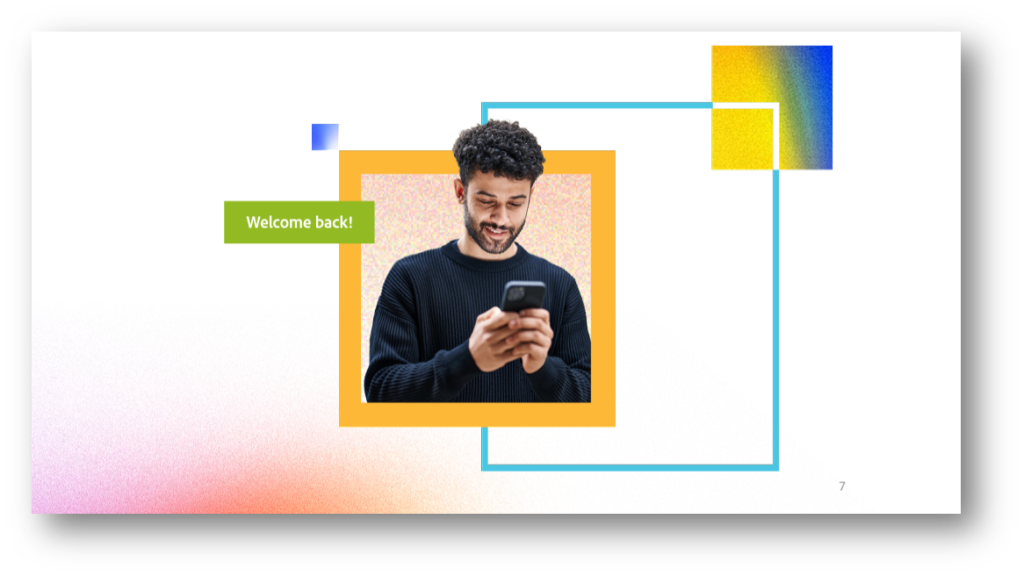
Out with the old.
When a customer moves on from your brand, it doesn’t take long for them to find another, especially if they had a subpar customer experience. In fact, 55% of customers will actively switch brands to get a better experience.
Since churn modeling and scoring are often calculated in systems that don’t receive real-time event data, typical win-back campaigns fail to realize the indicators of a dissatisfied customer. These infrequent calculations result in latent data and scores that are no longer relevant.
Building audiences in disparate systems leads to inconsistent experiences, isolated and incomplete churn models, and time-consuming duplicative workflows. When a brand lacks an understanding of each customer’s holistic experience with the brand across online and offline channels, their communications will inevitably be out of sync with customer needs.
In with the new.
Unified customer analytics tools use AI/ML to create models and scores that can spot and predict customer churn before it happens. By providing a unified view of customers from both online and offline channels, these solutions help you identify friction points, understand your campaign performance, and optimize your marketing efforts to improve the customer journey.
With intelligent “don’t lose” campaigns, you’ll be able to:
- Deeply understand customer behavior and sentiment to proactively spot risk signals as they occur.
- Use AI/ML to model propensity scores and understand correlation of certain signals that lead to churn.
- Create proactive campaigns to address individual customer needs and strengthen the relationship before it’s too late.
4. Evolving one-time value to lifetime value.
Customer lifetime value is one of the most important metrics that contribute to overall brand success—but just like any other relationship, you only get what you give. One-off, transactional consumer-brand relationships are a thing of the past. People crave personal, human experiences that make them feel understood as an individual.
However, most upsell, and cross-sell campaigns narrowly focus on recent purchases only. Brands need unified tools that focus on the whole customer by syncing behavioral, attribute, and preference data to create a lifetime of connected customer experiences.
Out with the old.
With typical upsell and cross-sell campaigns, the intended value of the interaction is heavily weighted toward the brand, not the customer. It’s a short-sighted strategy—stringing along one-time transactions, rather than focusing on providing long-term value, dilutes the value to both the customer and the brand.
Typically, these campaigns are derived from binary transactional events and logic instead of accounting for the entire customer relationship and journey. They disregard important signals, such as customer satisfaction, service engagement, and ongoing needs throughout their customer lifecycle.
In with the new.
You can rebalance the value exchange by putting the customer first with integrated, AI driven tools. These solutions account for all attributes, behavior, and preference data to evolve a one-time conversion into long-term, two-way value.
By focusing on building lifelong value, you can:
- Create personalized campaigns based on a specific customer’s attributes, behavior, and past purchases.
- Create multichannel journeys from a single canvas, embedding consistent brand messaging, imagery, and personalized offers.
- Apply AI models with flexible configuration and transparency to all customer data to understand propensity.
- Use AI-driven offer decisioning to deliver personalized offers based on real-time profiles.
- Deliver in-the-moment communications via email, SMS, text, in-app or push message based on customer actions or segment qualification changes.
5. Contextual recognition.
When a past customer engages with a brand online, chances are their experience will be personalized to some degree based on their previous interactions. But what if they’re not signed in?
With unauthenticated visitors, marketers typically ignore one-to-one considerations and deliver campaigns that are targeted at a broad base of unauthenticated traffic. When users are grouped together based on a minimal set of behavior commonalities, personalization and experiences suffer due to lack of relevancy.
This presents a significant missed opportunity, considering that 98% of site visitors are anonymous and 76% of consumers are more likely to purchase from brands that personalize. With contextual recognition, you can personalize to recognized users, regardless of their current authentication state, and account for in-the-moment context to deliver the best experience possible.
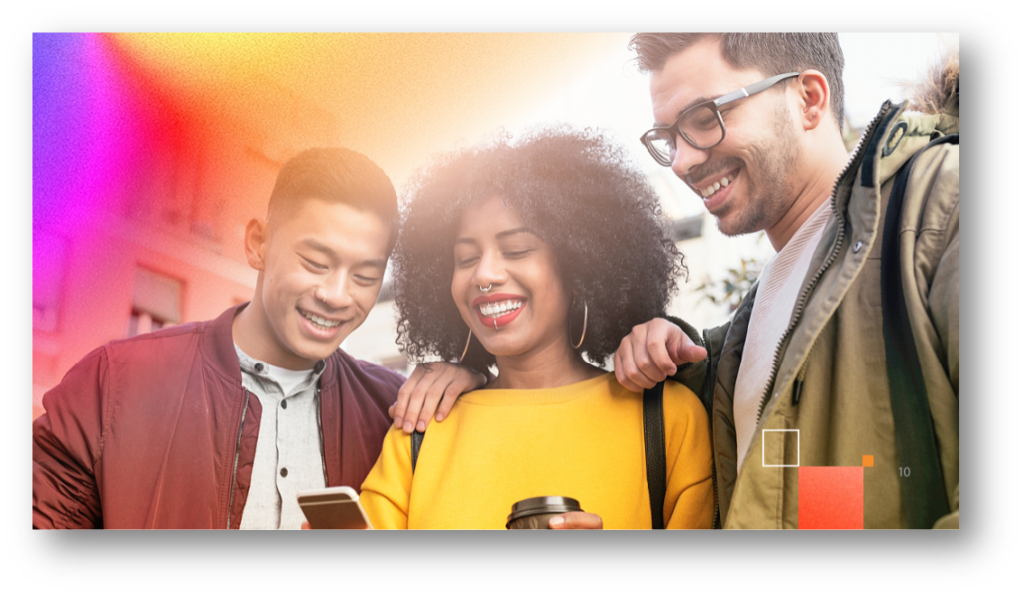
Out with the old.
Unauthenticated personalization campaigns typically operate from a disconnected point of view from all other customer data. They work solely from landing page and in-session activity and neglect one-to-one or nano-segment considerations that enable targeted campaigns for different cohorts.
Behavioral data is usually not included when defining audiences by trait-based information only in a customer data platform, creating blind spots in customer experience optimization. Additionally, online and offline event data is not stitched together, which makes it impossible to gain a holistic view of the customer journey.

In with the new.
With contextual recognition solutions, brands can recognize visitors and personalize their experience based on their past behavior and the current context of their visit. Regardless of the user’s authentication status, you can link data associated with a previously authenticated profile to provide a personalized, one-to-one experience across channels, devices, and more.
By creating a single customer profile that incorporates attribute data, behavioral data, segment qualification, and preferences, contextual recognition can help you:
- Recognize visitors who haven’t logged in, segment audiences, and publish them for activation.
- Recognize if a customer has signed in before and use the identity graph to link profile data to behavioral data to retarget across devices.
- Personalize site experience based on past browsing activity.
- Respect consumer privacy by preventing the merger of authenticated and unauthenticated profiles for personalization.
Personalized customer journeys start with Adobe.
Personalization isn’t the future of customer experience management—it’s the now. In fact, the Forrester report showed that 80% of B2C customers and 84% of B2B customers feel that personalization saves them time by making it easier to find information and settle decisions. And while implementing personalization at scale can feel complex, it doesn’t have to be. Adobe can help empower you to analyze, understand, and apply deep insights from your customers at the individual level, in a fraction of the time. And by unifying customer data from all channels and truly knowing your customers, from their first interaction throughout their entire customer journey, you can create connected customer experiences for life. Ready to find out how Adobe can transform your customers’ experience?
Sources
Customer Experience Research report, commissioned by IMImobile/Webex, 2023.
Personalization at Scale: Bring Forth the Customer and Business Benefits of Experience Excellence, a Forrester report commissioned by Adobe, 2023.
